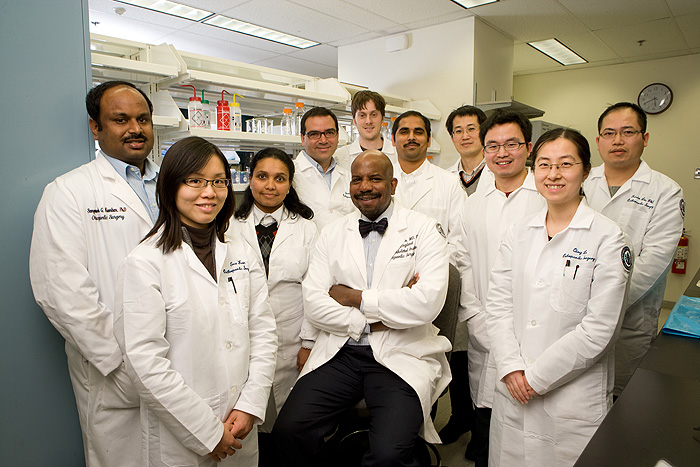
Internationally prominent philanthropists Raymond and Beverly Sackler have provided a major gift to create an innovative research center at the Institute for Regenerative Engineering at the UConn Health Center. The gift follows the recent passage of Gov. Malloy’s Bioscience Connecticut plan.
The Sacklers’ gift will enhance collaboration among the Health Center’s leading physical scientists, biomedical researchers, and engineering experts, including those within the multidisciplinary Institute for Regenerative Engineering, led by Dr. Cato T. Laurencin, an internationally recognized orthopaedic surgeon and tissue engineering expert.
An elected member of both the Institute of Medicine of the National Academy of Sciences and the National Academy of Engineering, Laurencin served as vice president for health affairs and dean of the UConn School of Medicine. He recently transitioned into a new role as chief executive officer of the Connecticut Institute of Clinical and Translational Science (CICATS), which will be an integral part of the Bioscience Connecticut initiative.
“The Sacklers’ gift proves that Gov. Malloy’s visionary Bioscience Connecticut plan also has the power to galvanize donors who have the passion and means to make a significant difference in the future of health care and our flagship academic medical center,” says UConn President Susan Herbst.
It has a focus on helping millions of patients regain mobility and strength by regenerating tissue and ultimately, complex tissue, limbs and organs. It can be described as the next generation of tissue regeneration because it combines the established principles of tissue engineering with morphogenesis, stem cell technology and the understanding of material cues for cellular growth and transformation.
 Regenerative engineering focuses on helping patients regain mobility and strength by regenerating tissue and ultimately, complex tissue, limbs, and organs. It can be described as the next generation of tissue regeneration, because it combines the established principles of tissue engineering with morphogenesis (the process that causes an organism to develop its shape), stem cell technology, and the understanding of material cues for cellular growth and transformation.
Regenerative engineering focuses on helping patients regain mobility and strength by regenerating tissue and ultimately, complex tissue, limbs, and organs. It can be described as the next generation of tissue regeneration, because it combines the established principles of tissue engineering with morphogenesis (the process that causes an organism to develop its shape), stem cell technology, and the understanding of material cues for cellular growth and transformation.
“We are grateful to Raymond and Beverly Sackler for their support and leadership in the field of regenerative engineering,” says Laurencin. “Here at the UConn Health Center, we are conducting some of the most advanced work in tissue regeneration in the world. As a clinician and scientist, I am incredibly excited about what this gift will mean for our capacity to break new ground in this field and other innovative fields in health care.”


